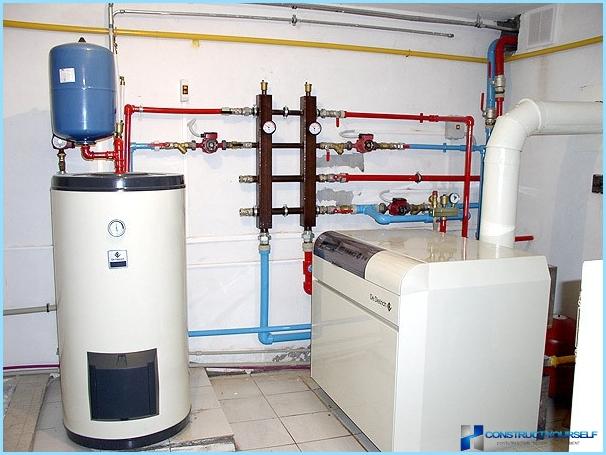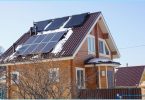The arrangement of the individual heating in a private house – a fundamental condition to ensure comfort. Therefore, the equipment of the boiler house to plan under construction or during major renovations. Regulatory compliance will help to create safe operating conditions of the heating system.
The location of the boiler ↑
Independent heating allows the operation of boilers running on different fuels. This includes equipment that generate heat by recycling gas, solid fuel, electricity or combined system. The location of the boiler depends on boiler type. Strict regulatory requirements apply to boilers running on natural gas or LPG. This is due to the high degree of explosion hazard.
Immediately below is located the boiler, using liquid and solid fuel. Lower level explosion does not negate regulatory requirements for equipment separate boiler room, well-equipped with ventilation and having a unique channel for output of waste gas.
The most simplified requirements apply when you install the electric boiler. The presence of an isolated area is not required, but are subject to other regulatory limits on safe operation of electrical equipment (selection of cable cross-sections, the organization of the ground, etc.).

General requirements for facilities ↑
Regulatory requirements for boilers, where there is gas and solid fuel boilers, largely coincide. There are several options for the location of the boiler in a private house:
- the boiler room is located in a separate building;
- adjoining the house is an Annex, is reserved for the boiler room;
- in a private house is allocated a separate room.
Sometimes there are cases of location of boiler in an external cell module or in the attic. Choices are influenced by several factors: the scale of construction or reconstruction, type of fuel used and boiler capacity.

Room settings ↑
Operation of solid fuel boilers common in regions where centralized gas supply is not available. Such equipment runs on wood, coal, peat or wood pellets. The boiler room should meet the following regulatory requirements:
- The ceiling is set at a level not less than 2.5 m.
- Minimum area is 8 mTwo.
- Accordingly, the volume of the room should not exceed 15 mThree.
- Regular loading of fuel and cleaning of the ash box includes the installation of the boiler in an easily accessible place. The implementation of this regulatory requirement is necessary in order not to create difficulties with maintenance and repair actions.
- The installation of the boiler provides for the formation of a minimum clearance between equipment and wall size 10 mm.
- For solid fuel boilers it is recommended that the arrangement of the podium, elevating off the floor by 8-10 cm.

- For fire safety the walls and the floor is made of non-combustible materials. If this requirement is not feasible, the place in front of the firebox is protected by a steel sheet with a minimum size of 50×50 cm, feature protection wall performs asbestos screen or sheet metal with a thickness of 0.25 cm.
- According to the approved regulations, boiler room, equipped in the extension, can be equipped with two doors: inside houses and in open space. Inner door is made of heat-resistant materials and are characterized by high fire safety requirements.
- Regulatory conditions include the organization in the boiler room of a private house natural and electric lighting. The calculation of the natural flow of light Bouncing off the volume of the room. 1 mThree areas must be 0.03 mTwo the glazed area. That is, when the minimum volume of a boiler room of 15 mThree, the square window opening is 0.45 mTwo.
- If the fuel is coal, the wiring in the room should be concealed, and lighting devices are chosen ad hoc, with hermetic protection. This is due to the high explosiveness of coal dust.
- Boiler room of a private house equipped with running water and sewage system. To exclude the possibility of freezing pipes during the cold period is called its insulation.
Requirements for arrangement of ventilation system and chimney are governed by the regulations of SNiP 2.04.05-91. The key is the process of ventilation provides for one hour three times a replacement of air in the boiler room of a private house.


Chimney ↑
Regulatory documentation on the equipment of a boiler room in a private home contains the following requirements:
- The size of the duct is calculated from the boiler’s power: 1 kW unit power amounts to 8 cmTwo the input area of the ventilation design. ?It is important! The diameter of the pipe coming from the heating unit to exceed the diameter of the chimney hole.
- Chimney channel has the same diameter along the entire length of the structure.
- Regulatory conditions involve the arrangement of the holes ensures the implementation of service procedures of the chimney.
- The device of the chimney pipe to the boiler using solid fuel, similar to a kiln design. Its height should exceed 5 m, and the number of twists and turns does not exceed three.
In addition to the correct design of the chimney, according to the normative requirements for safe operation of a boiler room in a private house includes the presence of natural and forced ventilation.

Natural ventilation ↑
There are two ways of removal from boiler flue waste from the combustion of solid fuel by natural and forced ventilation. Natural ventilation is carried out by:
- the arrangement of the holes in the ceiling and walls;
- window hardware window;
- the formation of the gap between the door leading into the room, and the floor.
Ventilation window depends on the location of the boiler and has features. When the device of the boiler in accordance with the regulatory requirements on the first floor of a private house, an exhaust hole equipped on the heating unit. Through it are oxygen depleted air, and combustion products trapped in the room. The process is carried out by the flow from the street fresh air through the vent.
To prevent outflow of fresh air from the boiler room inside a duct equipped with a check valve. Similarly equipped with exhaust hole. Installation of the valve were not provided, and the protection of the canopy from precipitation will come in handy. To comply with regulatory requirements, the supply hole in the boiler it is recommended to make as close as possible to the furnace so that the flow of fresh air quickly got into the combustion chamber.
This procedure ventilation the boiler is not amenable to regulation, it is directly dependent on the temperature, the wind load and pressure level. Regulatory requirements air the boiler should be updated three times within the hour, therefore, resort to the process of artificial ventilation.

Artificial ventilation ↑
Forced ventilation is carried out through the boiler equipment electric fans located at the exhaust inlet. Their power is calculated from the volume of the boiler, multiplied by three. For strict adherence to regulatory requirements, the obtained results increase by 10-30% to ensure a reserve of performance. Recommended fans for the boiler room of a private house, purchased in copper or aluminum housings for sustained resistance to high temperatures.
To realize the energy savings possible with equipment of the boiler system of automatic control of ventilation. Installation of monitoring equipment enables you to run the fans directly into the intensive period of the heating unit and translate them into pause mode at no load.

Distinctive features of electric forms of heating ↑
Operation of the electric boiler is characterized by a maximum level of security. Regulatory requirements do not require tooling for the boiler in a separate room, it is enough to allocate to it the free space in the kitchen. The advantages of the arrangement of an electric boiler includes the following items:
- available the price of the unit;
- the installation process is feasible without the involvement of specialists;
- compactness and absence of requirements for mandatory equipment separate boiler helps to save space;
- regulatory requirements do not imply the equipment of premises for the electric boiler with a flue;
- comfortable working conditions due to silent process that does not require regular monitoring of the number of fuel material;
- environmental safety.
In order to safe working, regulatory requirements stipulate that ground. A significant drawback of the boiler with an electric heating unit is a high energy cost. This is due to its rare use. The most practical when the equipment performs the function of additional heating source.

Coordination of the project ↑
The main condition of project approval must comply all the regulatory requirements of SNiP. First and foremost, it is necessary for the approval of the contract for laying the gas pipeline or the organization of its internal wiring. Prior to the arrangement of the boiler authorizing resolution is required to:
- from the fire service;
- in sanitary inspection;
- after inspection of the relevant boiler specialist in the Department of architecture;
- in the technical supervision and housing and communal services.
Only after registration of the relevant documents, from the design stage of the boiler, meeting all regulatory requirements, to go to its implementation. To speed up the approval procedure will help specialized company knowledgeable about all the nuances of the procedure of documenting.








